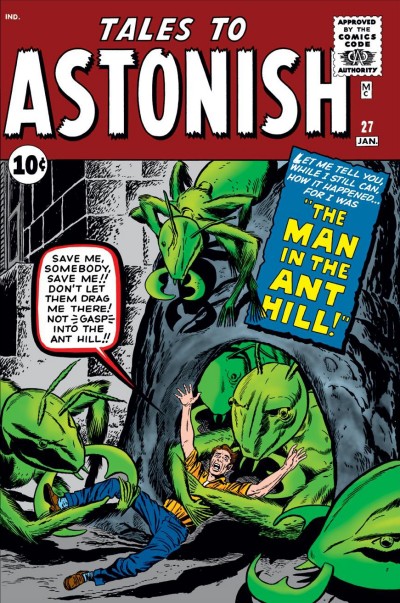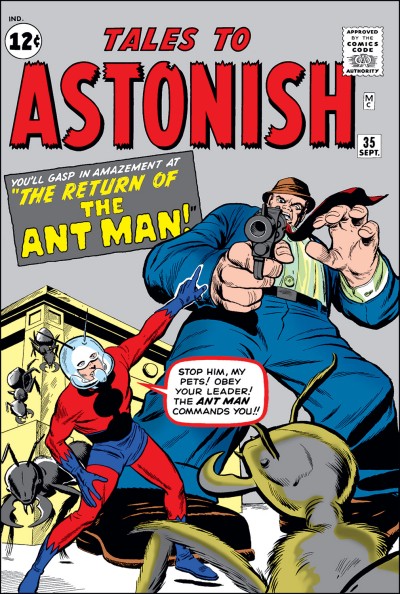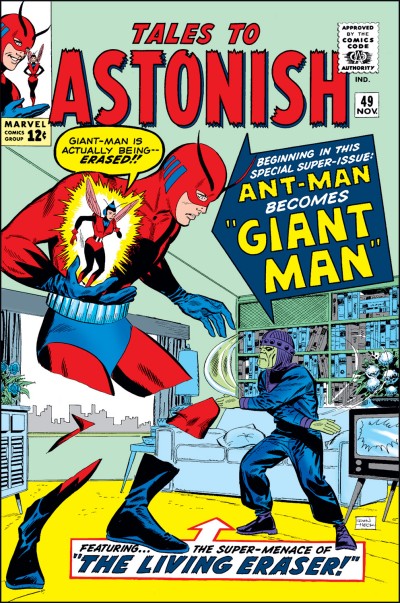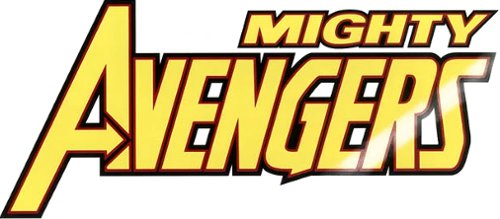BEFORE:
The idea of a shrinking super-hero was not new to comics. The first shrinking hero was published by Quality Comics early in the “Golden Age” of comic books. Created by none other than Will Eisner, “Doll Man” first appeared in 1939 in Feature Comics #27. He would appear in that title for most of the remainder of its series and in his own title of Doll Man, running into the early 1950s. Less than a decade later, in Showcase #34, DC Comics introduced its own shrinking hero in the Atom, a totally reimagined version of their own non-shrinking character from their Golden Age pantheon. This Atom was scientist Ray Palmer, who harnessed the power of “white dwarf star matter” to reduce his size and become a super-hero.
It was only a few months after the Atom’s first appearance in Showcase that Henry Pym made his own. While he shared traits with Ray Palmer in that he was an inventor who developed a method of reducing his own size, Henry Pym’s first story was not a super-hero tale. At the time, most of Marvel’s books were not super-hero titles. In fact, the Fantastic Four had only appeared the previous year and both Spider-Man and the Hulk had yet to be created. Rather, at this time, most of Marvel’s books were anthology series, examples of which were Journey into Mystery, Tales of Suspense and Tales to Astonish. Most of these 22+ page books had multiple stories, usually depicting some science fiction tale worthy of a 1950s “B-movie.”
Henry Pym first appeared in one such story in Tales to Astonish #27, a cautionary tale in which the young scientist Pym had invented a shrinking serum. In the short, 7-page story called “the Man in  the Ant Hill!” Dr. Pym inadvertently shrank himself, without thinking ahead about access to his corresponding “enlarging serum.” A series of decisions equally lacking foresight caused Pym to be lost in an anthill and almost eaten alive by the colony. Due to a combination of good luck and a helpful ant, Pym reached his enlarging serum and returned to his normal height. As with most stories of this kind, Pym destroyed his creation, deciding it too dangerous to be used by any human again.
the Ant Hill!” Dr. Pym inadvertently shrank himself, without thinking ahead about access to his corresponding “enlarging serum.” A series of decisions equally lacking foresight caused Pym to be lost in an anthill and almost eaten alive by the colony. Due to a combination of good luck and a helpful ant, Pym reached his enlarging serum and returned to his normal height. As with most stories of this kind, Pym destroyed his creation, deciding it too dangerous to be used by any human again.
Given the short gap in publication between Henry Pym’s first appearance in early 1962 and DC’s the Atom’s first appearance in late 1961, it is almost certain that the creation of Ray Palmer and his white dwarf star research had no connection to the creation of Henry Pym and his shrinking serum. However, by the fall of 1962, DC’s Atom had appeared in three issues of Showcase and had graduated to his own series. Whether or not the success of the Atom had any influence on Henry Pym’s return, by the summer of 1962, it was clear that Marvel’s flagship super-hero book of the Fantastic Four was not a fluke and what we now think as the beginning of the Marvel Universe was underway. The Incredible Hulk had debuted in May, with August bringing both Thor and Spider-Man. So it was in September that Henry Pym returned, this time not simply an unlucky scientist… but as a full-fledged super-hero.
Tales to Astonish (1st series) – (1962-1965)
Eight issues after his previous appearance, Henry Pym reappeared in Tales to Astonish #35. At this time (and for nearly the rest of the title’s run), Tales to Astonish would remain an anthology  series and so Henry Pym’s first foray as the Ant-Man would be shared with three other science fiction stories. Nevertheless, in this initial 13-page story, Henry Pym developed his classic cybernetic helmet, through which he could communicate with ants, and his first costume. His first foe was a ring of communist spies, a commonly used foe in Marvel’s early stories. For good measure, Ant-Man defeated a communist spy in his second story as well.
series and so Henry Pym’s first foray as the Ant-Man would be shared with three other science fiction stories. Nevertheless, in this initial 13-page story, Henry Pym developed his classic cybernetic helmet, through which he could communicate with ants, and his first costume. His first foe was a ring of communist spies, a commonly used foe in Marvel’s early stories. For good measure, Ant-Man defeated a communist spy in his second story as well.
While it is easy as a reader in hindsight to view early aspects of characters as being odd or downright silly, it is important to remember that this was very early in the creation of Marvel’s pantheon of heroes and writer Stan Lee, his brother writer Larry Lieber and artist (& undoubtedly co-plotter) Jack Kirby were flying by the seat of their pants, figuring out what worked and what did not. An example of this was Ant-Man’s preferred method of transportation, which was to shoot himself out of a miniature cannon across town, cybernetically contacting ants to amass where he would land to ensure a soft landing. (How he returned home never seemed to be addressed) Later, in a less-ballistic use of his ant allies, Ant-Man would utilize a flying ant for cross-town journeys. Transportation was not their only use, however. In addition to assisting with his landings, ants would regularly act as a spy network and would telepathically inform Ant-Man if individuals were talking about him or carry out espionage missions on his behalf.
In these early stories, Ant-Man’s place in the burgeoning shared Marvel Universe was unclear. Although Ant-Man seemed to be admired by local law enforcement and beloved by his fellow citizens, no other costumed heroes seemed to be mentioned (or otherwise referenced) by anyone. Also odd for Marvel series, dialogue in Tales to Astonish #42 & #43 made reference to Ant-Man protecting “Center City.” While DC had long been known to create fictional cities for their characters (such as Metropolis for Superman and Gotham for Batman), almost all Marvel characters seemed firmly established in New York City. The only exception was the Hulk, whose area of operations was in the American southwest. The only thing that seemed to tie Ant-Man to the other Marvel titles was his use of clothes and his costume being made of “unstable molecules,” an invention of the Fantastic Four’s leader, Mr. Fantastic. The use of these types of costumes and clothes was meant to explain how Ant-Man’s costume would shrink with him, though in fact it had been demonstrated in Pym’s first appearance in TTA #27 that his serum worked on normal clothes.
Most of this changed with #44, along with the addition of a new co-writer. Writing credits for Tales to Astonish #35-43 were either for Stan Lee alone or co-written by Stan and his brother, Larry  Lieber. TTA #44 brought Ernie Hart (credited as “H.E. Huntley”) as co-plotter and things seemed different right away. Without much fanfare, a casual mention was made to the George Washington Bridge, firmly planting Ant-Man’s home as New York City. Additionally, the very first inkling of Henry Pym’s backstory was given, detailing the political murder of his first wife Maria Pym by communist agents in her home country of Hungary.
Lieber. TTA #44 brought Ernie Hart (credited as “H.E. Huntley”) as co-plotter and things seemed different right away. Without much fanfare, a casual mention was made to the George Washington Bridge, firmly planting Ant-Man’s home as New York City. Additionally, the very first inkling of Henry Pym’s backstory was given, detailing the political murder of his first wife Maria Pym by communist agents in her home country of Hungary.
Tales to Astonish #44 also brought Ant-Man’s co-star, the Wasp, into his book. While male super-heroes had long had girlfriends, they usually were an impediment to the hero’s secret identity and one who would regularly need saving. The introduction of the Wasp inverted this in several ways. In her first story, Pym not only revealed his identity but provided abilities to her that were not only comparable to his own but, considering her ability to fly with her own wings, superior to his. Additionally, the two did not date, as Pym considered himself “too old” for the young Janet van Dyne. Although on a surface level this could have been considered forward-thinking in terms of equality, Janet also displayed flighty and shallow attributes, with her romantic advances on the edge of being annoying. Nonetheless, the Wasp was definitely more than a supporting character and received co-billing on their stories. Oddly, for seven issues running between #52 & 59, there were back-up tales in which the Wasp would tell a nearby character a science fiction story, running 5 to 7 pages. As all seemed to be the typical sci-fi story of Tales to Astonish, they were most likely completed products which Marvel had previously commissioned and were repurposed by simply adding a Wasp framing sequence to include a super-hero character.
As noted earlier, Stan Lee and his co-writers were creating their mythos as they went along. While most readers today refer to Pym’s given name as “Hank,” it was not actually used until #47, a year after his first appearance as Ant-Man. Likewise, “Pym Particles” was never used in Tales to Astonish. This term would not be used until the OHOTMU entry for Ant-Man II (Scott Lang) in the Official Handbook of the Marvel Universe Deluxe Edition #1 and not in-story until West Coast Avengers (2nd series) #18 in 1987. Rather, in its first two appearances, Pym’s invention was a “serum” in TTA #27 & #35, becoming a gas with #36. In TTA#44, Henry Pym had managed to encapsulate his shrinking and enlarging formula into a pellet form that could be swallowed. An even more useful advance came with TTA #58 in which Pym incorporated his size-changing catalysts into a cybernetic helmet, allowing him to change size at will. Much later in the Avengers title, it was explained that prolonged exposure to his formula “conditioned” Pym’s body to change without a catalyst.
By this time, however, Pym had technically abandoned the identity of Ant-Man. With Tales to Astonish #49, Pym had used his new capsule technology to increase his size, rather than shrinking it. Settling at a maximum height of twelve feet for technical reasons, Hank Pym adopted  a new costume with a cybernetic cowl (rather than a mandible-inspired helmet) and naming himself Giant-Man. Oddly however, Pym would use both Giant-Man and Ant-Man names interchangeably for the near future, referring to himself as Giant-Man while he was enlarged but thinking of himself as Ant-Man when he was reduced. Example of these are in TTA #52, 54, 56, 57, 58, 59, 60, 62 & 64. This dichotomy was put to an end with Tales to Astonish #67 in which an alien removed Hank Pym’s ability to shrink to ant-size, relegating him to his normal height or his identity of Giant-Man.
a new costume with a cybernetic cowl (rather than a mandible-inspired helmet) and naming himself Giant-Man. Oddly however, Pym would use both Giant-Man and Ant-Man names interchangeably for the near future, referring to himself as Giant-Man while he was enlarged but thinking of himself as Ant-Man when he was reduced. Example of these are in TTA #52, 54, 56, 57, 58, 59, 60, 62 & 64. This dichotomy was put to an end with Tales to Astonish #67 in which an alien removed Hank Pym’s ability to shrink to ant-size, relegating him to his normal height or his identity of Giant-Man.
In later interviews, Stan Lee lamented that Ant-Man had never been as popular as he had hoped. It is probably for this reason that changes were made following Tales to Astonish #69. Starting with #60, the Tales to Astonish title had been slightly repurposed from a book with an Ant-Man & Wasp story with science fiction anthology stories to a co-feature with the two size-changing heroes and the Hulk, whose own title had been canceled the previous year with #6. Since #60, Giant-Man and Wasp had shared cover billing with the Hulk. With #70, stories with Namor the Sub-Mariner replaced the size changing duo. Eventually, the Tales to Astonish title would be rechristened Incredible Hulk (2nd series) with #102.
Nonetheless, Ant-Man (and the Wasp) appeared in 35 stories in Tales to Astonish. During this time, he faced off against several longtime foes. The greatest of these was Egghead, who would arguably be Hank Pym’s archnemesis. Although he matched wits with Egghead in four stories, Ant-Man had to outthink the self-styled Human Top in five issues. Years later, this criminal would drop his questionable name and adopt the more fearsome name of Whirlwind. Also making their first appearance in the Marvel Universe was the Porcupine, a man later known as the villain simply called Voice and the original, villainous Black Knight. The nephew of this armored criminal would later become an Avenger.
| Writers | Artists |
|---|---|
|
|
